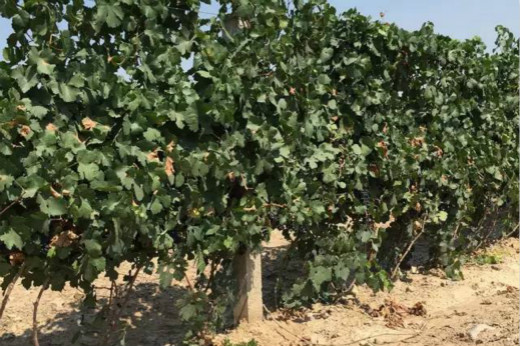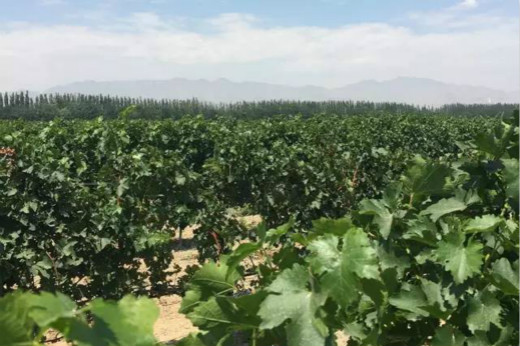Wine Production at the East Foot of Helan Mountain Region
Date£º
2015-09-10 11:50 Source£º
ProWine Author:
Ian Dai Translator:
China is often mistaken for having a long winemaking history, as an ancient Chinese poem starts with the line ¡°From cups of jade that glow with wine of grapes at night¡±. In fact, there¡¯s no continuation of the wine culture from the Tang Dynasty (618-907), during which time the poem was written. Instead, grain alcohol becomes a mainstream drink in China. The winemaking industry in modern China is established on the basis of European techniques. Therefore, China is one of the New World wine regions.
The East Foot of the Helan Mountain Region is a young and upcoming wine region in China. It has gained tremendous fame when a vineyard in the region, Chateau Helan Qingxue picked up the international trophy at the Decanter World Wine Awards with its Jia Bei Lan cabernet dry red 2009 wine. The East Foot of the Helan Mountain region became the center of spotlight overnight. In 2015, this region is already one of the most popular and attractive wine regions in China with its great public attention, the largest number of prize won and the biggest number of newly established chateaus.

It¡¯s worth mentioning that, not so long ago, most of the wine produced here was Cabernet. Local winemakers often mix four grape varieties together, i.e. Cabernet Sauvignon, Cabernet Franc, Cabernet Gernischt and Merlot. This technique is different from the common blend due to impure varieties. Producers often mix-plant those grape varieties and dump the entire harvest into the fermentation tank without any assortment.
It¡¯s not long ago when the local vineyards were still using the so-called ¡°dragon¡¯s head¡¯ pruning system¡± which was designed for growing table grapes. Grape bearing zones differ in heights, which will cause different degrees of maturity over the clusters, making it difficult for fine wine management.
Before Jia Bei Lan and Silver Heights came into public view, it was not popular to age wine in oak barrels in the East Foot of the Helan Mountain wine region. The common practice was to ferment and store the wine in stainless steel tanks and bottle as according to orders. Though using oak barrels for aging red wine has become the standard practice nowadays, stainless steel tanks are still in use as storage utensil for wine. The conventional wine making process includes fermentation, aging and bottling at appropriate times. If bottled without any demand, the wine will face great oxidation risk. As this region has long been in the business of base wine trading and OEM, and the chateaus lack effective sales channels for their own brands, it¡¯s a much safer option to leave the wine in tanks waiting for orders, or else trade as base wine.
In spite of this, the East Foot of the Helan Mountain is the best region for making wine in China! Its 3,000 hours of sunlight is capable of maturing red wine grapes, represented by Cabernet Sauvignon, to a sound degree. The dry climate equals low risks for plant diseases and insect pests. The great day-and-night temperature difference as a result of high altitude well preserves the acidity of soil. The only shortcomings of this region include the necessity for covering the vine with soil for overwintering and the highly saline alkali soil that lacks organic matter. But what else can one wish for?

The young East Foot of the Helan Mountain region has a long history of being the production base for quality wine grapes. The fame gained by Chateau Helan Qingxue and Silver Height in 2009 has led the region into the era of boutique winery. In 2011, major companies such as Pernod Richard, Moet Hennessy, and Daylong made investments in basic research (winemaking equipment and technologies) in the region, aiming for further developments. The establishment of a large number of boutique wineries that followed has placed Ningxia on the global winemaking arena. This is still a fledging wine region with dues to pay and lessons to learn. At the moment, everything is looking up, but more is to come. Time shall be invested in this long learning curve.
To be on the constructive side or to find fault, if one must, it is important to emphasize on communication. It¡¯s not among the strongest suit for China¡¯s winemakers to deal with fellow industry players, which has led to unfortunate jealousy and infighting. The rise of a wine region requires generations of hard work. The ideal mindset shall be that everyone is willing to share and care for the region as a whole instead of only focusing on one¡¯s own vineyard. The development of the New World clearly reflects this. Shake off the fetters! As an old saying goes: One shall first of all make the cake BIG.
£ªThe East Foot of the Helan Mountain Region: The region is located on the east side of the Helan Mountain. Geographically, most of the region sits within the boundary of Yinchuan City. Major winemaking areas of Ningxia Province are situated here.